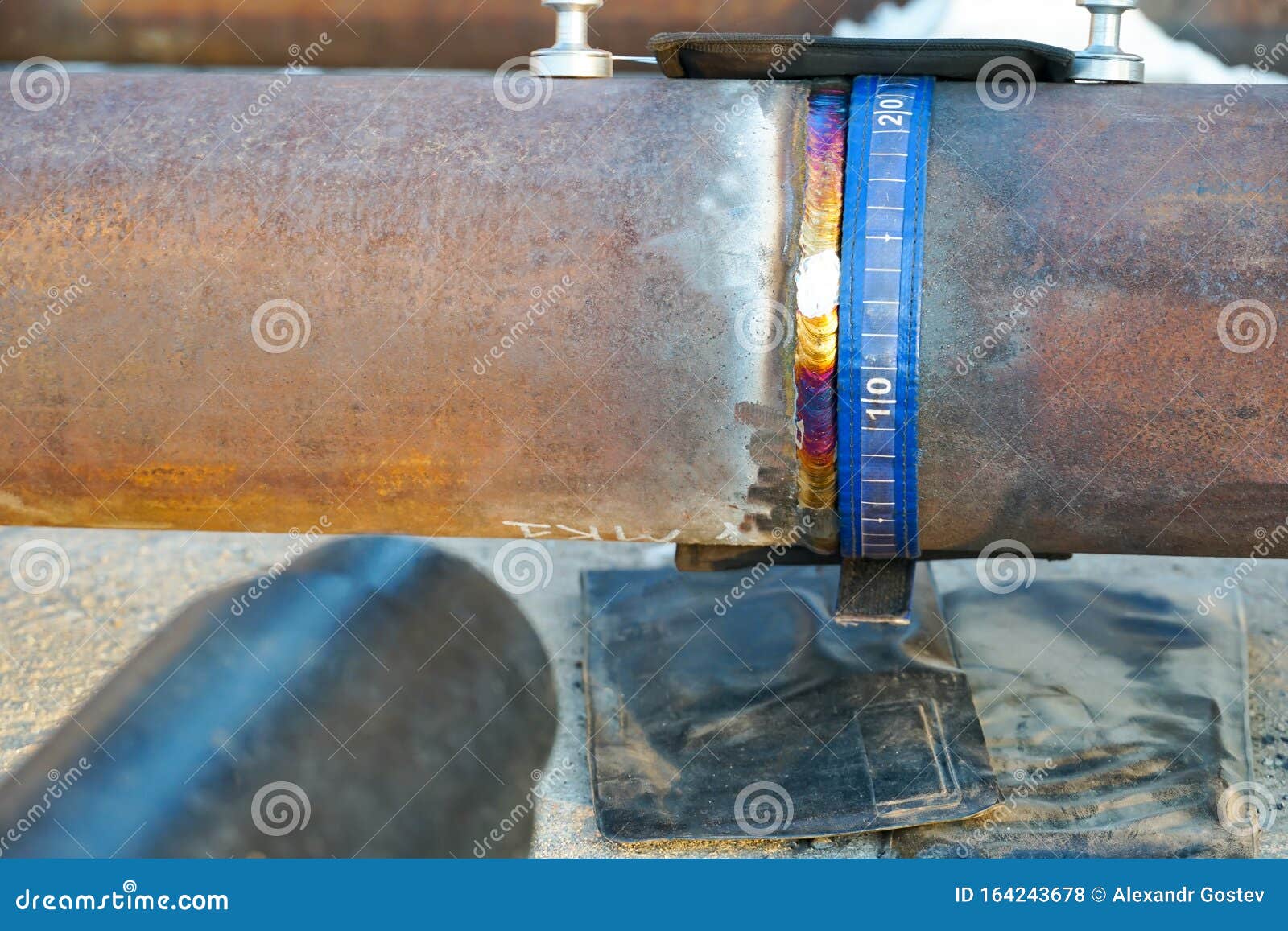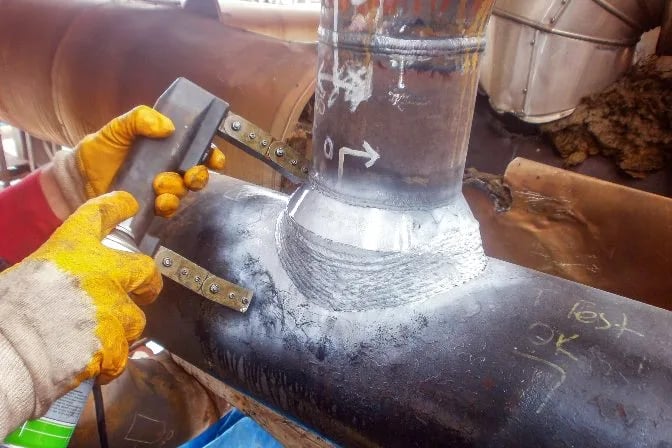Comprehensive Introduction of Pipe Welding Evaluation Treatments
In the world of pipeline building and construction, making sure the honesty and safety and security of bonded joints is critical. Pipe welding evaluation treatments play a vital duty in guaranteeing that bonded links fulfill stringent market requirements and specifications. From thorough pre-welding inspections to comprehensive post-weld assessments, a distinct assessment process is crucial for keeping the architectural stability of pipelines. Understanding the ins and outs of welding assessment procedures is not only a governing requirement however also a basic facet of supporting the dependability of these crucial frameworks.
Pre-welding Evaluation Preparations
Before starting the welding procedure, thorough pre-welding evaluation preparations are crucial to make certain the stability and quality of the weld joint. These preparations include a meticulous examination of the materials to be bonded, the welding tools, and the workplace. Firstly, the materials must be examined for any kind of defects, impurities, or incongruities that can compromise the weld. This includes checking for proper product grades, dimensions, and surface area conditions. Pipeline Welding Inspection. In addition, the welding devices requires to be examined to validate that it remains in excellent functioning condition, calibrated properly, and ideal for the specific welding process. Any type of issues with the devices must be dealt with without delay to stop defects in the weld. The job atmosphere must be assessed for cleanliness, appropriate ventilation, and security measures to ensure a helpful setup for the welding procedure. By performing complete pre-welding inspection preparations, prospective problems can be recognized and resolved at an early stage, leading to trustworthy and top notch weld joints.
Welding Procedure Qualification
Complete pre-welding inspection preparations lay the foundation for the vital process of Welding Procedure Qualification, ensuring the honesty and quality of the weld joint. Welding Treatment Qualification (WPQ) is an important action in the welding procedure that includes screening and certifying welding procedures to assure they fulfill details requirements and needs. The WPQ process normally consists of welding treatment spec advancement, welding procedure qualification screening, and documentation of the results.
Throughout welding procedure spec advancement, crucial details such as the welding process, welding products, joint layout, and welding specifications are defined to create an extensive procedure. Consequently, welding procedure credentials testing is conducted to verify the suggested procedure's stability. This testing often entails welding examination promo codes that undergo different mechanical and non-destructive examinations to assess the weld's quality and adherence to the specified criteria.
In-process Weld Evaluation
During the welding procedure, in-process weld examination plays a critical function in making certain the quality useful reference and honesty of the weld joint - Pipeline Welding Inspection. This kind of evaluation includes keeping an eye on the welding parameters, evaluating the weld grain development, and detecting any type of prospective flaws or discontinuities as they occur. By performing in-process weld inspections, welding operators can quickly attend to any concerns that might arise, consequently guaranteeing and avoiding additional defects that the final weld satisfies the needed specs
Usual approaches made use of for in-process weld evaluation consist of aesthetic evaluation, liquid penetrant testing, magnetic particle screening, ultrasonic testing, and radiographic screening. Visual assessment is usually the initial step while doing so, allowing examiners to aesthetically analyze the weld for surface area irregularities such as cracks, porosity, or incomplete fusion. Advanced approaches like ultrasonic testing and radiographic screening provide thorough insights into the interior structure of the weld, making sure that there are no concealed issues that might endanger the weld joint's toughness and integrity. On the whole, in-process weld examination is essential for preserving the high quality and dependability of bonded pipelines.
Non-destructive Testing (NDT)
Non-destructive Screening (NDT) is an essential approach employed in pipe welding inspection to examine the integrity of weld joints without causing damage to the welded framework. By making use of numerous NDT methods, examiners can assess the high quality of welds and identify any type of flaws or gaps that may endanger the architectural soundness of the pipe. Typical NDT approaches used in pipe welding assessment consist of Radiographic Screening (RT), Ultrasonic Testing (UT), Magnetic Fragment Testing (MPT), Fluid Penetrant Testing (LPT), and Visual Screening (VT)
RT includes the usage of X-rays or gamma rays to produce photos of the internal framework of the weld, enabling assessors to spot issues such as porosity, cracks, or incomplete combination. In addition, VT involves visual examination of welds to recognize have a peek at this website any type of noticeable blemishes.
Post-weld Evaluation and Documentation


Documents of post-weld evaluation findings is necessary for keeping quality assurance records and ensuring conformity with sector criteria and laws. In-depth reports should consist of info regarding the inspection approaches made use of, the place and nature of any kind of defects discovered, and any kind of restorative actions taken - Pipeline Welding Inspection. Proper paperwork not only acts as a record of the weld's top quality however additionally aids in future maintenance and evaluation processes
Final Thought

In verdict, pipe welding evaluation treatments play an essential duty in making certain the high quality and stability of welds. Generally, adherence to appropriate assessment methods is key to the success of pipeline welding projects.
From thorough pre-welding examinations to detailed post-weld assessments, a well-defined evaluation process is essential for keeping the architectural click here for more sturdiness of pipes. By conducting in-process weld inspections, welding drivers can immediately resolve any type of issues that may arise, consequently protecting against further flaws and making certain that the last weld fulfills the needed requirements.
Typical approaches made use of for in-process weld assessment consist of aesthetic assessment, liquid penetrant screening, magnetic particle screening, ultrasonic screening, and radiographic screening.Non-destructive Screening (NDT) is a critical method employed in pipeline welding inspection to evaluate the stability of weld joints without triggering damages to the bonded framework. Post-weld inspection entails various methods to examine the welds for flaws, including aesthetic assessment, dye penetrant testing, magnetic fragment screening, ultrasonic testing, and radiographic testing.